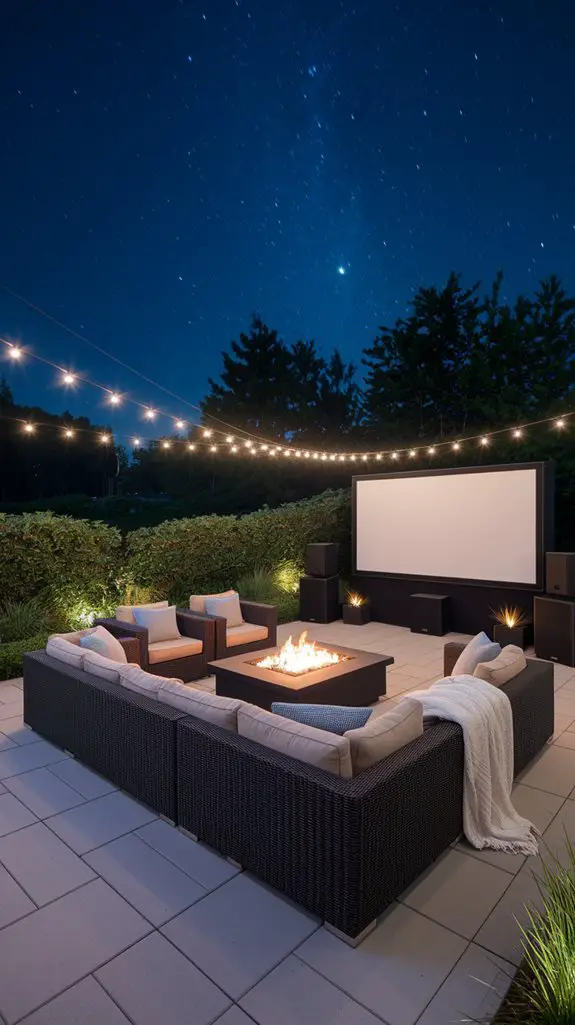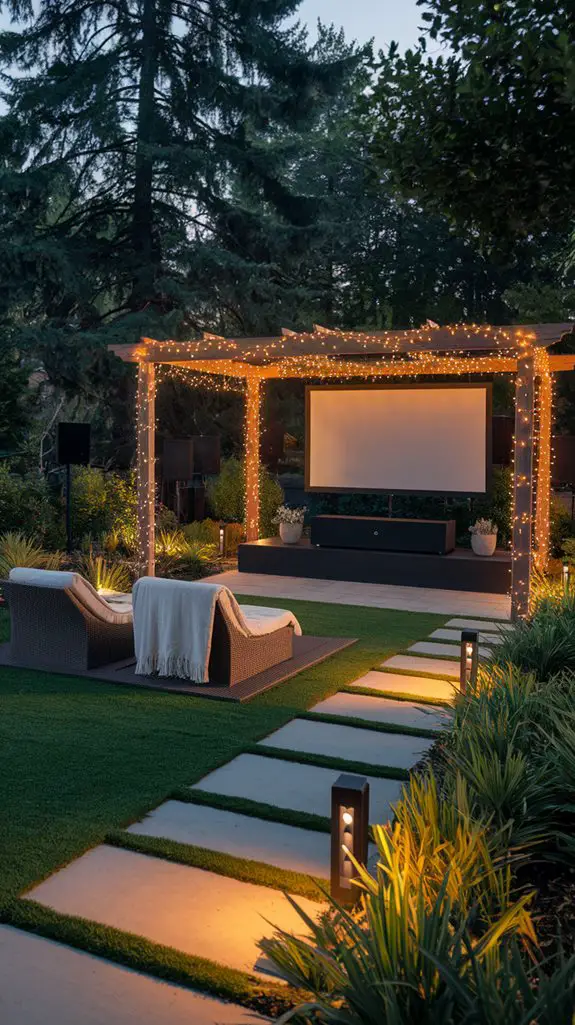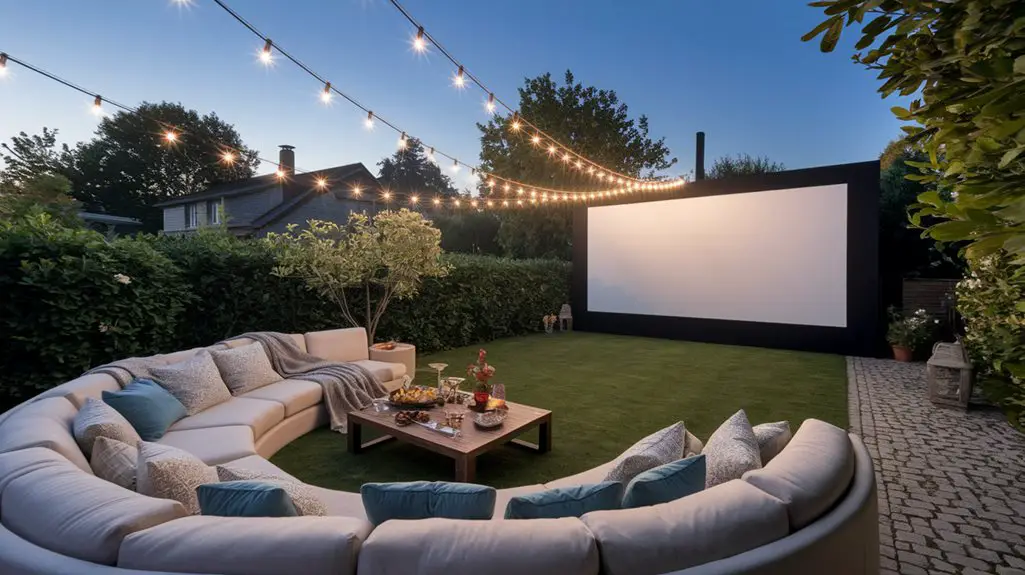Like Gatsby's green light beckoning across the bay, an outdoor cinema promises endless summer evenings of entertainment under the stars. You'll discover that creating this home theater experience isn't just about technology, but about crafting an environment where memories are made. From inflatable screens that transform garden spaces to sophisticated poolside setups with marine-grade components, the perfect outdoor theater balances technical precision with atmospheric charm. Let's explore your options.
Inflatable Movie Screen Gardens
Inflatable movie screen gardens represent one of the most versatile solutions for outdoor home theater enthusiasts. These pneumatic display systems integrate seamlessly into landscaped environments while providing ideal viewing surfaces ranging from 8-20 feet diagonal.
You'll need to establish proper anchoring—either via ground stakes or ballast weights (15-20 lbs per corner)—to guarantee stability in winds up to 15 mph. Position your inflatable screen perpendicular to prevailing wind patterns to reduce aerodynamic load.
Most quality units utilize 210D oxford nylon with specialized reflective coatings that achieve 1.1-1.3 gain ratios. For best performance, maintain 12-15 psi inflation pressure while accounting for temperature fluctuations.
Dedicated air pumps (minimum 750W output) establish initial inflation, while smaller maintenance pumps (120W) compensate for microscopic leakage. Consider semi-permanent installation with quick-disconnect fittings to expedite future setup procedures.
Dedicated Patio Theater Setups

While temporary setups offer flexibility, dedicated patio theater installations provide superior viewing experiences through permanent integration with your outdoor living space.
Mount a weather-resistant 4K projector (minimum 3,000 lumens) on reinforced pergola beams or under eaves using marine-grade hardware. Install a fixed-frame, ambient light rejecting (ALR) screen with 16:9 aspect ratio—typically 100"-120" diagonal for ideal viewing.
Implement in-ceiling or landscape speakers in a 5.1 configuration, with buried conduit for cabling and a waterproof equipment cabinet housing your AVR, streaming devices, and surge protection.
Incorporate IP65-rated lighting on dimmers integrated with your control system. Terminate HDMI runs at under 50 feet to prevent signal degradation, or implement HDBaseT transmitters for longer distances.
Consider outdoor-rated acoustic panels to minimize sound reflection.
Hidden Outdoor Sound Systems

How effectively can audio integrate into your landscape without visual intrusion? Remarkably well, using strategic speaker placement and camouflage techniques.
Opt for weatherproof satellite speakers (IP66-rated minimum) mounted beneath eaves or nestled within plantings. Consider burial-grade subwoofers installed below ground level with only mushroom-shaped ports visible.
Zone-based systems allow tailored audio distribution across viewing and peripheral areas via 70V transformers. Implement acoustic absorption strategies—surrounding hard surfaces with vegetation reduces unwanted reflections.
For seamless integration, match speaker colors to surroundings or select rock-formation enclosures that blend with landscape elements.
Wire management requires direct-burial-rated cabling (UF or DB cables) at minimum 16AWG thickness, ideally 14AWG for runs exceeding 50 feet. Plan for accessible junction points to facilitate future system modifications.
Poolside Cinema Experiences
Creating a poolside cinema setup requires specialized equipment configurations to address the unique challenges of water proximity and reflective surfaces.
Install IP66-rated weatherproof projectors mounted 9-12 feet above deck level to prevent splash damage. Position your screen perpendicular to the pool's long edge to minimize viewing angle distortion for in-water viewers.
For audio, deploy marine-grade speakers with 70-volt transformers in a distributed array around the pool perimeter. Configure your receiver with a 10ms delay compensation to counteract the reflection lag from water surfaces.
Implement a vapor-barrier conduit system for all wiring runs, using marine-grade THWN conductors and watertight junction boxes.
Select a nanocoated ALR (Ambient Light Rejecting) screen with 1.2-1.4 gain to combat the doubled ambient light from water reflections.
Pergola-Mounted Projection Systems
Pergolas offer three distinct advantages as projection system mounts for outdoor theaters: structural support, partial weather protection, and aesthetic integration.
When mounting your projector, utilize the pergola's horizontal beams to install a weatherproof housing unit with proper ventilation to prevent overheating. Configure your projection angle at 15-20° downward to optimize screen visibility and minimize keystone distortion.
- Install a retractable projection screen (100-120") on the pergola's front facade with tensioning systems to prevent wind disruption.
- Route all cabling through weatherproof conduit along pergola beams, maintaining 6" separation between power and HDMI lines to prevent interference.
- Implement a waterproof equipment cabinet beneath the pergola for housing your AV receiver, media player, and surge protection components. Additionally, consider using high-quality projectors that are specifically designed for outdoor environments to ensure a bright and clear image.
Weather-Resistant Entertainment Decks
While pergolas provide overhead structure for projection equipment, a weather-resistant entertainment deck forms the foundation of your outdoor theater experience.
Opt for composite decking materials like Trex or TimberTech that resist moisture, UV damage, and temperature fluctuations. Install proper drainage channels with a 1/4" per foot slope to prevent water pooling near electronics.
Integrate weatherproof junction boxes for power distribution and CAT6 connectivity. Consider recessed deck lighting with IP67-rated LED fixtures at 2700K for ideal viewing conditions without screen washout.
For audio integration, install in-deck speaker mounts with waterproof covers.
Apply marine-grade polyurethane sealant to all penetrations and utilize stainless steel fasteners (316-grade) to prevent corrosion. Implement a vapor barrier beneath the deck to protect underside wiring from ground moisture. Additionally, ensure your setup includes functional outdoor kitchen designs for an all-in-one entertainment experience.
Portable Backyard Theater Kits
Three portable backyard theater kits offer flexibility for homeowners who prefer impermanent setups or have limited space.
These all-in-one solutions integrate projectors, speakers, and screens in weather-resistant configurations that deploy in under 30 minutes and store compactly off-season.
Select models feature 1080p native resolution, 3000+ lumens brightness, and IP65 weatherproofing.
- AKIA Cinema Pop-Up (7.5kg) combines a short-throw DLP projector with 100" screen and Bluetooth connectivity, requiring minimal calibration between uses.
- Outdoor Theater Supply Pro-2500 features amplified 20W speakers with passive radiators for enhanced bass response in open-air environments.
- ViewSonic Portable Theater includes auto-keystone correction, ambient light rejection screen, and modular components for customization based on viewing area dimensions.
Cozy Fire Pit Viewing Areas
Integration of dual-purpose fire pits creates an ideal viewing environment that combines ambient warmth with strategic illumination for year-round outdoor theater enjoyment. Opt for a gas-powered fire feature with BTU output between 40,000-60,000 for best heat radius without screen glare interference. Position your fire pit 8-12 feet from the viewing area, ensuring 45° sightlines remain unobstructed. Select non-reflective surround materials like textured stone or matte-finished concrete to minimize light bounce. For enhanced functionality, consider recessed seating configurations with 18-22" seat heights and 5° backrests for ergonomic viewing angles. Install directional heat shields on the screen-facing side to redirect thermal output. Supplement with weatherproof throw pillows featuring 1.8 lb/ft³ density foam cores and solution-dyed acrylic covers for maximum comfort and durability. Additionally, incorporating cozy outdoor spaces around the fire pit can enhance the overall atmosphere of your outdoor theater setup.
Outdoor Movie Nooks With Ambient Lighting
Strategic ambient lighting transforms outdoor movie nooks into immersive viewing environments, complementing the warmth provided by fire pit setups.
Implement low-voltage LED pathway markers (3-5 watts) to delineate viewing boundaries while preventing trip hazards. Position 2700K color temperature uplights behind seating to create depth perception without screen glare.
- Install IP65-rated LED strip lighting with dimming capability (12V DC, 2.4 watts/foot) along pergola edges or under bench seating for adjustable ambiance.
- Mount weatherproof RGBW smart bulbs (9W) in strategic locations to modify color temperature based on content genre (3000K for dramas, 4000K for sports).
- Incorporate solar-powered stake lights with photocell sensors for automatic dusk activation, eliminating manual setup.
Additionally, consider adding seasonal backyard lighting decor elements to enhance the overall aesthetic and create a more inviting atmosphere.
Sunken Seating Theaters With Surround Sound
Creating a recessed viewing area elevates the outdoor theater experience through enhanced acoustics and defined spatial boundaries. Excavate a 12-18" depression in your yard, then frame it with pressure-treated lumber or masonry. This sunken design naturally creates a 5.1 surround sound pocket where audio waves concentrate rather than dissipate.
Install weatherproof speakers in a proper array: front L/R channels at 22-30° angles, center channel aligned with screen, and rear surrounds at 90-110° positions. Mount subwoofers on isolation platforms to minimize ground vibration transfer. For ideal performance, incorporate acoustic treatments—outdoor-rated bass traps at corners and diffusion panels on nearby vertical surfaces. Additionally, consider incorporating weatherproof projection solutions that can withstand outdoor elements for an uninterrupted viewing experience.
Your seating should feature moisture-resistant upholstery with marine-grade foam cores. Implement tiered rows with a 12° viewing angle for unobstructed sightlines to your weather-resistant projection screen.
Conclusion
Your outdoor cinema begins with your AV configuration, but reaches its potential through meticulous site evaluation and calibration. You'll need to calculate ideal throw distance, account for ambient light's effect on contrast ratio, and tune your speaker system to counteract acoustic distortion from open-air environments. Consider a dedicated 12V power system rather than extension cords, and install IP65-rated components to withstand environmental variables while preserving your content's dynamic range.




